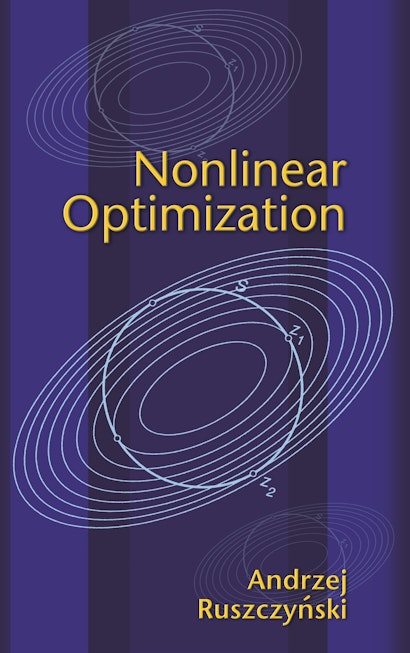Optimization is one of the most important areas of modern applied mathematics, with applications in fields from engineering and economics to finance, statistics, management science, and medicine. While many books have addressed its various aspects, Nonlinear Optimization is the first comprehensive treatment that will allow graduate students and researchers to understand its modern ideas, principles, and methods within a reasonable time, but without sacrificing mathematical precision. Andrzej Ruszczynski, a leading expert in the optimization of nonlinear stochastic systems, integrates the theory and the methods of nonlinear optimization in a unified, clear, and mathematically rigorous fashion, with detailed and easy-to-follow proofs illustrated by numerous examples and figures.
The book covers convex analysis, the theory of optimality conditions, duality theory, and numerical methods for solving unconstrained and constrained optimization problems. It addresses not only classical material but also modern topics such as optimality conditions and numerical methods for problems involving nondifferentiable functions, semidefinite programming, metric regularity and stability theory of set-constrained systems, and sensitivity analysis of optimization problems.
Based on a decade’s worth of notes the author compiled in successfully teaching the subject, this book will help readers to understand the mathematical foundations of the modern theory and methods of nonlinear optimization and to analyze new problems, develop optimality theory for them, and choose or construct numerical solution methods. It is a must for anyone seriously interested in optimization.
Andrzej Ruszczynski is Professor of Operations Research at Rutgers University. He is the coauthor of Stochastic Programming and the coeditor of Decision Making under Uncertainty.
"This book offers a very good introduction to differentiable and nondifferentiable nonlinear optimization theory and methods. With no doubt the major strength of this book is the clear and intuitive structure and systematic style of presentation. This book can be recommended as a material for both self study and teaching purposes, but because of its rigorous style it works also as a valuable reference for research purposes."—Mathematical Modeling and Operational Research
"This is one of the best textbooks on nonlinear optimization I know. Focus is on both theory and algorithmic solution of convex as well as of differentiable programming problems."—Stephan Dempe, Zentralblatt MATH Database
"In summary, this book competes with the topmost league of books on optimization. The wide range of topics covered and the thorough theoretical treatment of algorithms make it not only a good prospective textbook, but even more a reference text (which I am happy to have on my shelf.)"—Franz Rendl, Operations Research Letters
"Throughout the book the writing style is very clear, compact and easy to follow, but at the same time mathematically rigorous. The proofs are easy to follow because the author usually carefully explains every move. In addition the meaning of the most central results is usually demonstrated with examples and in many cases explanations are also supported by visualizations...This book offers a very good introduction to differentiable and nondifferentiable nonlinear optimization theory and methods...Recommended as a material for both self study and teaching purposes"—Petri Eskelinen, Mathematical Methods of Operation Research
"Nonlinear Optimization will become the standard textbook on its subject, as well as a reference book that everyone will want to own. Not only is it beautiful and elegant, it is also utterly comprehensive and modern, with many realistic and interesting examples."—Robert J. Vanderbei, Princeton University, author of Linear Programming
"This excellent book is the best I have reviewed in the past ten years. Very well written, its three main strengths are its treatment of theory and algorithms on equal terms, its mathematically driven presentation of the material, and its interesting examples and applications."—Ekkehard W. Sachs, Virginia Tech and Universität Trier

